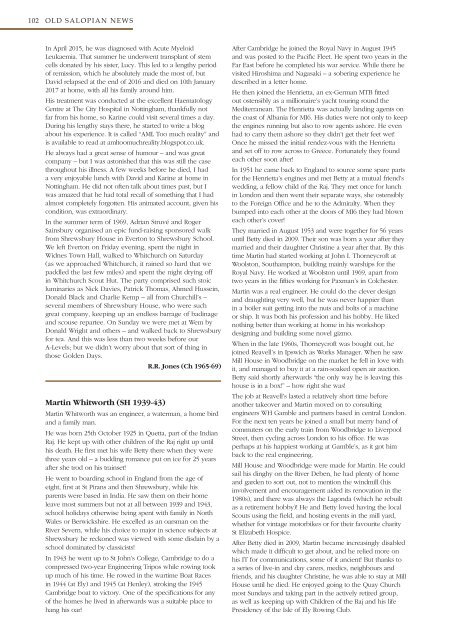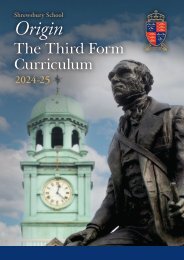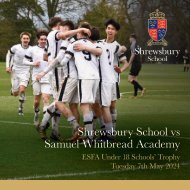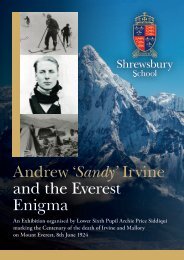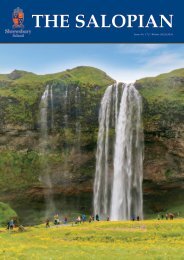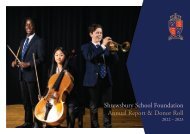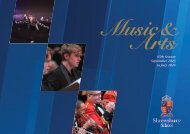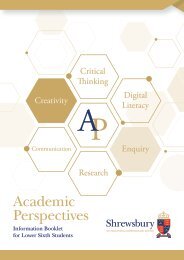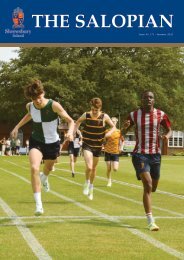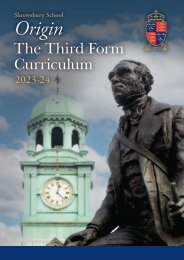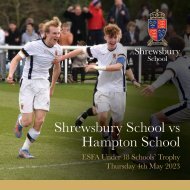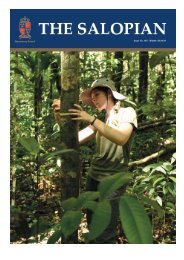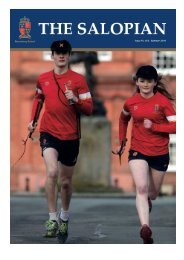The Salopian no. 160 - Summer 2017
- No tags were found...
Create successful ePaper yourself
Turn your PDF publications into a flip-book with our unique Google optimized e-Paper software.
102<br />
OLD SALOPIAN NEWS<br />
In April 2015, he was diag<strong>no</strong>sed with Acute Myeloid<br />
Leukaemia. That summer he underwent transplant of stem<br />
cells donated by his sister, Lucy. This led to a lengthy period<br />
of remission, which he absolutely made the most of, but<br />
David relapsed at the end of 2016 and died on 10th January<br />
<strong>2017</strong> at home, with all his family around him.<br />
His treatment was conducted at the excellent Haematology<br />
Centre at <strong>The</strong> City Hospital in Nottingham, thankfully <strong>no</strong>t<br />
far from his home, so Karine could visit several times a day.<br />
During his lengthy stays there, he started to write a blog<br />
about his experience. It is called “AML Too much reality” and<br />
is available to read at amltoomuchreality.blogspot.co.uk.<br />
He always had a great sense of humour – and was great<br />
company – but I was astonished that this was still the case<br />
throughout his illness. A few weeks before he died, I had<br />
a very enjoyable lunch with David and Karine at home in<br />
Nottingham. He did <strong>no</strong>t often talk about times past, but I<br />
was amazed that he had total recall of something that I had<br />
almost completely forgotten. His animated account, given his<br />
condition, was extraordinary.<br />
In the summer term of 1969, Adrian Struvé and Roger<br />
Sainsbury organised an epic fund-raising sponsored walk<br />
from Shrewsbury House in Everton to Shrewsbury School.<br />
We left Everton on Friday evening, spent the night in<br />
Widnes Town Hall, walked to Whitchurch on Saturday<br />
(as we approached Whitchurch, it rained so hard that we<br />
paddled the last few miles) and spent the night drying off<br />
in Whitchurch Scout Hut. <strong>The</strong> party comprised such stoic<br />
luminaries as Nick Davies, Patrick Thomas, Ahmed Hussein,<br />
Donald Black and Charlie Kemp – all from Churchill’s –<br />
several members of Shrewsbury House, who were such<br />
great company, keeping up an endless barrage of badinage<br />
and scouse repartee. On Sunday we were met at Wem by<br />
Donald Wright and others – and walked back to Shrewsbury<br />
for tea. And this was less than two weeks before our<br />
A-Levels; but we didn’t worry about that sort of thing in<br />
those Golden Days.<br />
R.R. Jones (Ch 1965-69)<br />
Martin Whitworth (SH 1939-43)<br />
Martin Whitworth was an engineer, a waterman, a home bird<br />
and a family man.<br />
He was born 25th October 1925 in Quetta, part of the Indian<br />
Raj. He kept up with other children of the Raj right up until<br />
his death. He first met his wife Betty there when they were<br />
three years old – a budding romance put on ice for 25 years<br />
after she trod on his trainset!<br />
He went to boarding school in England from the age of<br />
eight, first at St Pirans and then Shrewsbury, while his<br />
parents were based in India. He saw them on their home<br />
leave most summers but <strong>no</strong>t at all between 1939 and 1943,<br />
school holidays otherwise being spent with family in North<br />
Wales or Berwickshire. He excelled as an oarsman on the<br />
River Severn, while his choice to major in science subjects at<br />
Shrewsbury he reckoned was viewed with some disdain by a<br />
school dominated by classicists!<br />
In 1943 he went up to St John’s College, Cambridge to do a<br />
compressed two-year Engineering Tripos while rowing took<br />
up much of his time. He rowed in the wartime Boat Races<br />
in 1944 (at Ely) and 1945 (at Henley), stroking the 1945<br />
Cambridge boat to victory. One of the specifications for any<br />
of the homes he lived in afterwards was a suitable place to<br />
hang his oar!<br />
After Cambridge he joined the Royal Navy in August 1945<br />
and was posted to the Pacific Fleet. He spent two years in the<br />
Far East before he completed his war service. While there he<br />
visited Hiroshima and Nagasaki – a sobering experience he<br />
described in a letter home.<br />
He then joined the Henrietta, an ex-German MTB fitted<br />
out ostensibly as a millionaire’s yacht touring round the<br />
Mediterranean. <strong>The</strong> Henrietta was actually landing agents on<br />
the coast of Albania for MI6. His duties were <strong>no</strong>t only to keep<br />
the engines running but also to row agents ashore. He even<br />
had to carry them ashore so they didn’t get their feet wet!<br />
Once he missed the initial rendez-vous with the Henrietta<br />
and set off to row across to Greece. Fortunately they found<br />
each other soon after!<br />
In 1951 he came back to England to source some spare parts<br />
for the Henrietta’s engines and met Betty at a mutual friend’s<br />
wedding, a fellow child of the Raj. <strong>The</strong>y met once for lunch<br />
in London and then went their separate ways, she ostensibly<br />
to the Foreign Office and he to the Admiralty. When they<br />
bumped into each other at the doors of MI6 they had blown<br />
each other’s cover!<br />
<strong>The</strong>y married in August 1953 and were together for 56 years<br />
until Betty died in 2009. <strong>The</strong>ir son was born a year after they<br />
married and their daughter Christine a year after that. By this<br />
time Martin had started working at John I. Thorneycroft at<br />
Woolston, Southampton, building mainly warships for the<br />
Royal Navy. He worked at Woolston until 1969, apart from<br />
two years in the fifties working for Paxman’s in Colchester.<br />
Martin was a real engineer. He could do the clever design<br />
and draughting very well, but he was never happier than<br />
in a boiler suit getting into the nuts and bolts of a machine<br />
or ship. It was both his profession and his hobby. He liked<br />
<strong>no</strong>thing better than working at home in his workshop<br />
designing and building some <strong>no</strong>vel gizmo.<br />
When in the late 1960s, Thorneycroft was bought out, he<br />
joined Reavell’s in Ipswich as Works Manager. When he saw<br />
Mill House in Woodbridge on the market he fell in love with<br />
it, and managed to buy it at a rain-soaked open air auction.<br />
Betty said shortly afterwards “the only way he is leaving this<br />
house is in a box!” – how right she was!<br />
<strong>The</strong> job at Reavell’s lasted a relatively short time before<br />
a<strong>no</strong>ther takeover and Martin moved on to consulting<br />
engineers WH Gamble and partners based in central London.<br />
For the next ten years he joined a small but merry band of<br />
commuters on the early train from Woodbridge to Liverpool<br />
Street, then cycling across London to his office. He was<br />
perhaps at his happiest working at Gamble’s, as it got him<br />
back to the real engineering.<br />
Mill House and Woodbridge were made for Martin. He could<br />
sail his dinghy on the River Deben, he had plenty of home<br />
and garden to sort out, <strong>no</strong>t to mention the windmill (his<br />
involvement and encouragement aided its re<strong>no</strong>vation in the<br />
1980s), and there was always the Lagonda (which he rebuilt<br />
as a retirement hobby)! He and Betty loved having the local<br />
Scouts using the field, and hosting events in the mill yard,<br />
whether for vintage motorbikes or for their favourite charity<br />
St Elizabeth Hospice.<br />
After Betty died in 2009, Martin became increasingly disabled<br />
which made it difficult to get about, and he relied more on<br />
his IT for communications, some of it ancient! But thanks to<br />
a series of live-in and day carers, medics, neighbours and<br />
friends, and his daughter Christine, he was able to stay at Mill<br />
House until he died. He enjoyed going to the Quay Church<br />
most Sundays and taking part in the actively retired group,<br />
as well as keeping up with Children of the Raj and his life<br />
Presidency of the Isle of Ely Rowing Club.


